Highlights of Sarejevo, Bosnia
Sarajevo – a cosmopolitan city of deep history and diverse culture
The Balkans country of Bosnia and Herzegovina (once part of the former Yugoslavia) may not come to mind when thinking about places you want to visit. But after our recent Collette Taste of the Balkans tour, Mr. TWS and I strongly recommend that you consider it. The country’s name comes from its two regions, Bosnia (largest part of the country) and Herzegovina (the smallest area in the south). Sarajevo, the country’s capital city, is in the Bosnia region, beautifully situated on the Miljacka River surrounded by mountains and forests.
The diversity of activities, food, and cultures — characteristic of our entire tour, but especially in Bosnia — is exactly what we like to experience when we travel. We especially liked the expert information and immersive experiences provided by our guides and locals in Bosnia and throughout the Balkans tour, which also included several days in Croatia, Montenegro, and Slovenia.
Sarajevo — where East meets West
As we explored Sarajevo, it became clear why it is considered to be the city where “East meets West” with its blend of Ottoman and Austro-Hungarian cultures. The influences of the Eastern architecture of the Old City (Stari Grad) established in the Ottoman era beginning in 1461 quite clearly contrasted with that of the Western influences of the Austria-Hungary period, combining to make Sarajevo a cosmopolitan city of diversity that extends to people and culture.
The Old City of Sarajevo
Baščaršija is the oldest part of the city. Spreading out from Baščaršija Square there are several narrow alleys lined with craft shops. Historically, the workshops of craftsmen were located with others in their trade on each street, such as blacksmiths on Bravadžiluk and coppersmiths on Kazandžiluk. Today, there are still artisans who have followed in the footsteps of their ancestors, but the area is now most popular for traditional restaurants and food shops.
A central feature of the old city is the sebilj (shown above on the right), an Ottoman-style wooden fountain in Baščaršija Square.
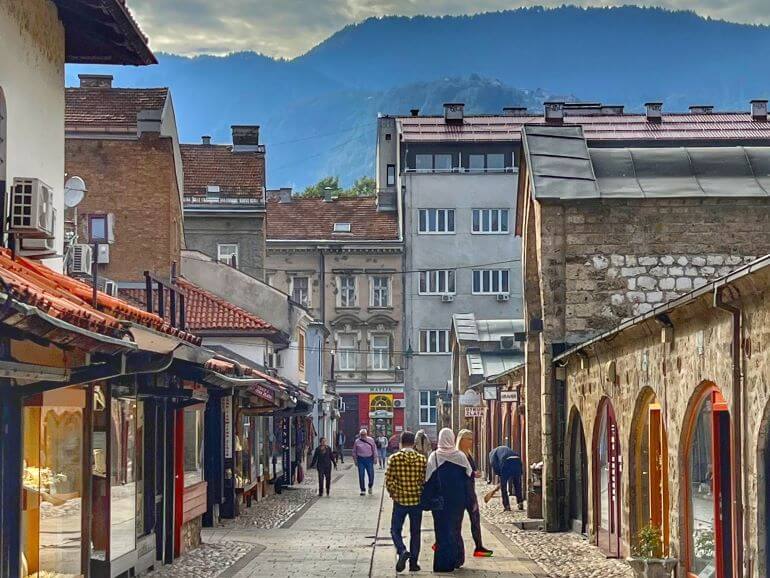
Shopping in the old city of Sarajevo
We particularly enjoyed watching and listening to a coppersmith as he performed his craft and described what he was doing. He is the latest in a long line of his family who were coppersmiths, including his father and grandfather, who taught him the craft. Particularly interesting were the creations he made from the many shell casings that have been found years after the Bosnian War.
The old city is vibrant night and day. Cafes are popular as drinking Bosnian’s famously strong coffee is a central part of a local’s day. Bakeries with sweet pastries (particularly a wide variety of baklava) and restaurants serving traditional fare like ćevapi and burek line the narrow streets. Since Bosnia is a predominately Muslim country, alcohol is not served in most establishments, but there are a few bars that can be found in the old city.
Latin Bridge and Museum of Sarajevo Assassination
To many, Sarajevo is known as the starting place of World War I because Archduke Franz Ferdinand of Austria and his wife Sophie, Duchess of Hohenberg, were assassinated here by a young Serb nationalist, Gavrilo Principon and thus began a series of events ultimately leading to the war. Walking along the Miljacka river, we crossed the Latin Bridge (built during the times of Ottoman rule) at Obala Kulina bana and Zelenih beretki streets to the site of the June 1914 assassination. We didn’t go inside the Museum of Sarajevo located here, but took a few minutes to contemplate the enormously consequential event that took place where we stood, next to a replica of the vehicle in which the archduke and his wife were assassinated.
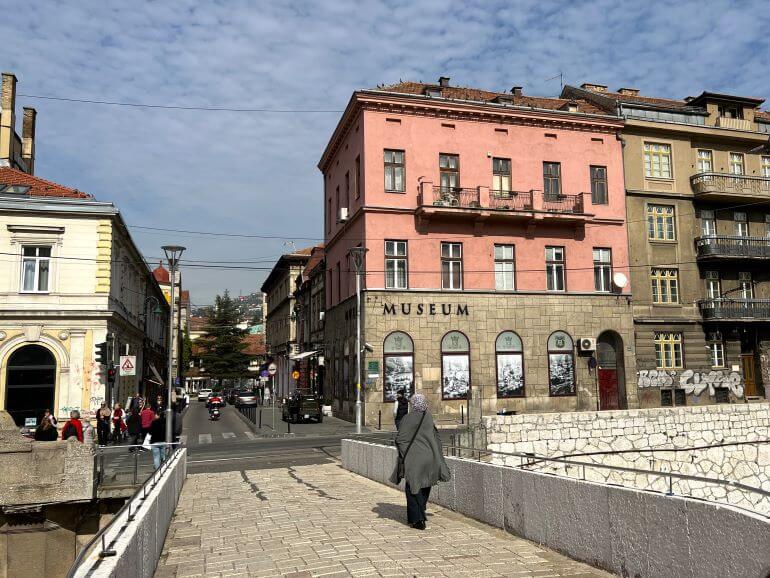
Latin Bridge and the site of the assassination of Archduke Ferdinand (the black car just to the left of the museum)
The siege of Sarajevo and the Tunnel of Hope
One of the most impactful experiences we had on the tour and in Bosnia was an excursion that immersed us in what is a defining historical time — the Bosnian War and the Siege of Sarajevo in the early 1990s. Although we followed the war closely in the news while it was going on, this excursion brought back to mind those tragic times and really gave us a deeper understanding and appreciation of what the people of Sarajevo endured.
Led by a local siege soldier and survivor, Amir, we visited the Sarajevo Tunnel Museum and the Tunnel of Hope. During the war, the 800-meter long/1.5-meter high tunnel was the sole source of food, arms, medical supplies, other humanitarian aid, and even cables providing power and communications that helped enable Sarajevo to survive the siege by Bosnian Serbs that lasted for nearly four years. Today, visitors can walk down a 20-meter portion of the tunnel to get a feel for what it would have been like. Of course, the conditions were significantly better for us than what it would have been like during the siege. During the war, there was no ventilation and many had to wear masks and there was often water on the ground.
Because the cost of reconstruction is so great, the ravages of war are still evident in Sarajevo as you see bullet and projectile marks on many buildings, such as those in the photo above at the Tunnel of Hope museum. The red markings on the ground outside of the museum building are called “Sarajevo Roses” and are also seen throughout the city in places where Serbian shelling left craters which have been filled with red paint, representing the blood that was spilled on those spots.
At the age of 15-1/2, Amir became one of the many volunteers to the Bosnian Army helping to defend against the Serbian army inside Sarajevo and he subsequently became one of the people moving goods through the tunnel every day. His first-hand experiences about the siege, the war, the tunnel, and the people of Sarajevo were fascinating. But something that really stands out to us is his optimism about the future of Bosnia. The war had been a very bitterly fought one killing many in Sarajevo (11,541 killed, including 1,601 children) and much destruction. Remarkably, Amir is optimistic that peace will continue and believes that and there should be no residual resentment or seeking of revenge because they are all Bosnians.
The soulful sounds of Sevdah
Another highlight of our tour was a home-hosted dinner and private performance at the Sarajevo residence of Damir Imamović, one of the most famous of Bosnian singers and composers. His specialty genre is Sevdah, a form of Bosnian folk music that has evolved over the centuries. Conversing with our small group and other locals while savoring traditional dishes, we were introduced to Damir who, in between songs, regaled us with stories of his musical inspiration and the unique Turkish-style tambur instrument he plays. He also shared his feelings on the impact of Sarajevo’s history on its people and how he expresses that through his music.
You can listen to a recording from our visit here: Damir Imamović
Sarajevo vistas on a cable car ride
Mr. TWS and I can’t resist a cable car or funicular ride when we visit a place, so we were thrilled to get a chance to take this eight-minute ride during our free time. Originally built in the 1950s, the Sarajevo cable car was destroyed in 1992 during the war. In 2018, it reopened with 33 gondolas that carry about 10 passengers each. At the top of Mt. Trebević is a coffee shop with an outdoor patio offering spectacular views of the city and surrounding mountains.
Veliki Park
We felt very safe walking around Sarajevo in the city center and near our hotel, Colorsinn Hotel Sarajevo which was very close to Veliki Park (the largest park in Sarajevo). On the night we arrived, we took a lovely walk uphill through the park to a restaurant for dinner. We chose a small restaurant called Noovi Wine and Food at Tina Ujevića 13 across from the park. The service and food were great, and the atmosphere was comfortable and casual.
Park tip: In the park there is the Memorial to the Murdered Children of Besieged Sarajevo dedicated to the over 1,600 children who were killed during the Siege of Sarajevo.
Other Bosnia highlights — day trips from Sarajevo
Day trip to Lukomir
A Collette optional excursion took us into the beautiful highland areas of northern Bosnia, past Mt. Bjelašnica (site of some of the XIV Winter Olympics) and further to the remote village of Lukomir. The village is about 26 miles from Sarajevo and partially reached by several miles of gravel road. I loved this drive and admiring fall colors, gazing at sheep and cows in pastures and walking along the road, and the rugged landscape.
It was like stepping back in time as we drove into the small village dotted with old stone houses. Women in traditional Bosnian dress were knitting clothing items to be sold to visitors like us, and men and women were working in their gardens. Our lunch was served outside at a small inn and restaurant in the village and consisted of delicious burek (both meat the spinach versions) accompanied by fresh mulberry and blueberry juices made with local ingredients of the village.
At the far end of the village, a moderately steep path takes you to a hilltop where there are stunning panoramic views of mountains all around.
Note: The village is only accessible from April to December.
An afternoon in Mostar, Herzegovina
On our way to Sarajevo from Kotor in Montenegro, another wonderful destination on our tour, we drove a little over three hours to the city of Mostar on the Neretva River in the Herzegovina region of Bosnia for lunch and sightseeing.
Following a filling multi-course lunch at Restaurant Šadrvan, we spent time exploring the old town. The area of Stari Most (Old Bridge) is a UNESCO World Heritage Site. The bridge itself looks very old, but was actually rebuilt less than 20 years ago since the original structure (built in 1566) was destroyed in 1993 during the war. The bridge is rather steep and the stones can be slick, so watch your step as you walk across. Be sure to stop and watch the divers making impressive jumps into the river from a nearby platform.
In the Old Bazaar there are many galleries and shops with traditional crafts for souvenirs.
Traditional foods of Bosnia
We ate very well in Bosnia and really enjoyed traditional dishes such as those in the photos below. From the top left: ćevapi (grilled meat sticks in pita); djuvec rice dish; fried dough and assorted cheeses, burek (spinach and cheese stuffed phyllo version shown — I also had the main meat version). All of it was so tasty and the portions were always generous.
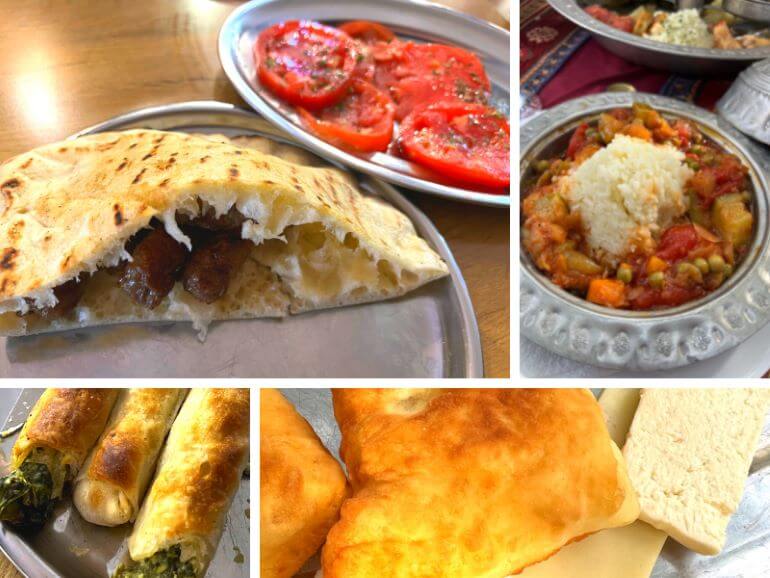
Traditional Bosnian dishes — Ćevapi, Djuvec vegetable and rice dish, fried dough and cheese assortment, Burek
The delicious Bosnian specialty pastries, especially the various kinds of baklava, could satisfy anyone with a sweet tooth.
And there’s more about our Balkans trip to come.
Disclosure: Our tour in Bosnia and Herzegovina was sponsored by Collette, but the opinions and perspectives expressed in our post are totally our own, as always.

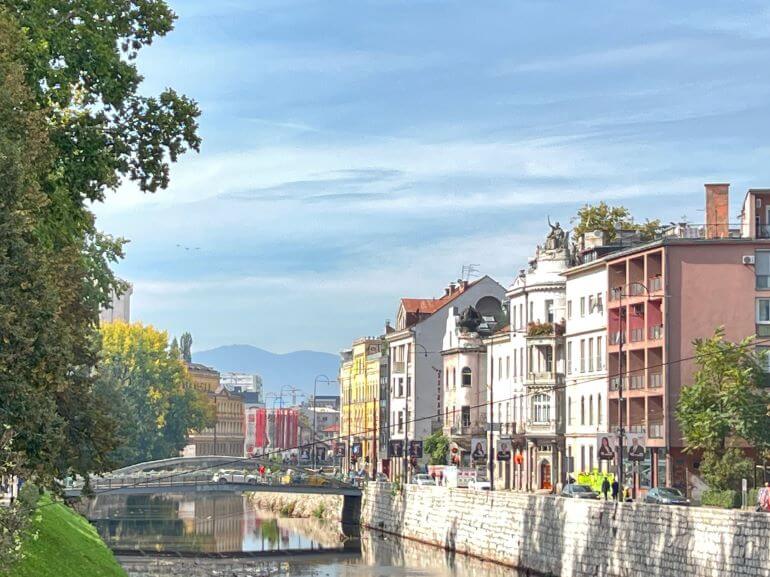
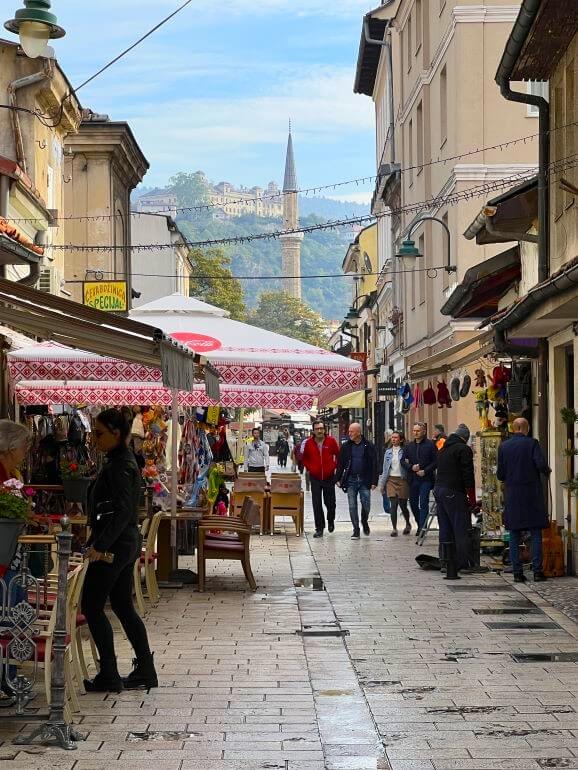
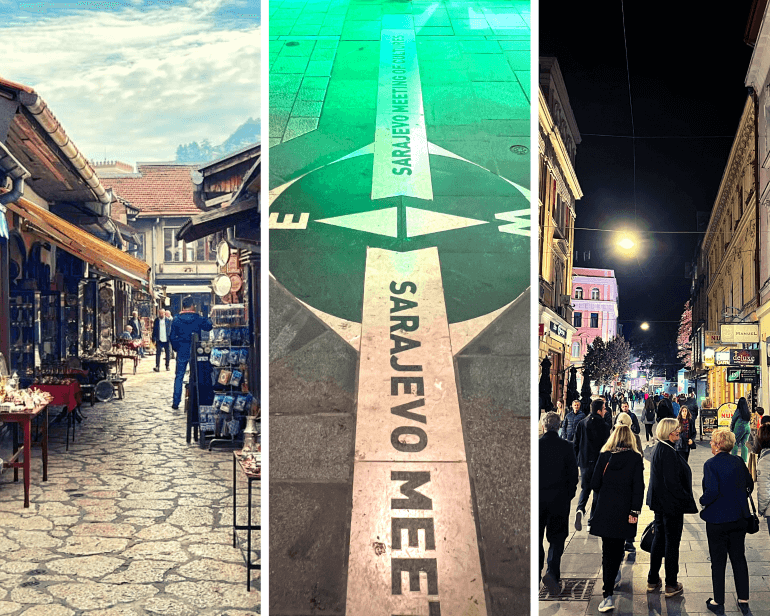
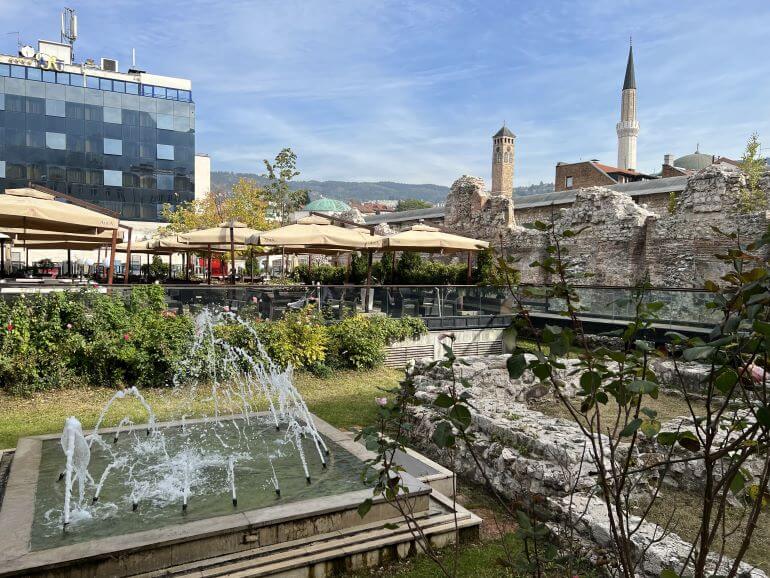
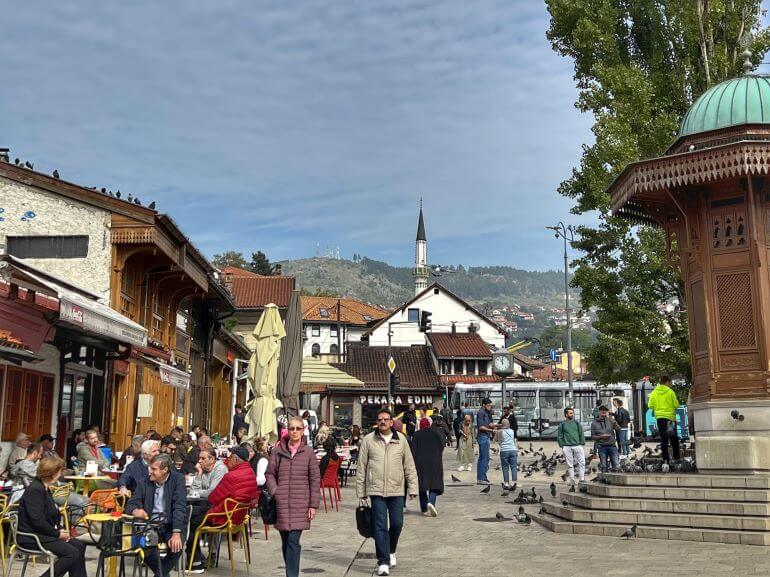
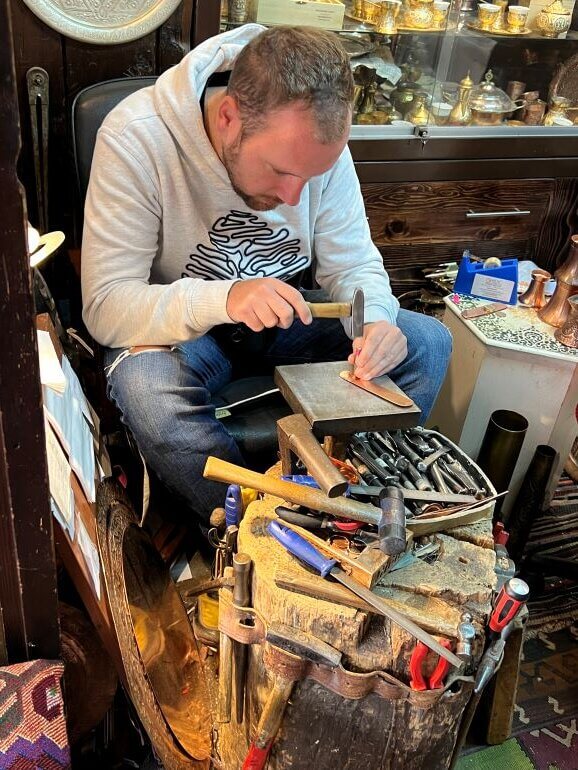
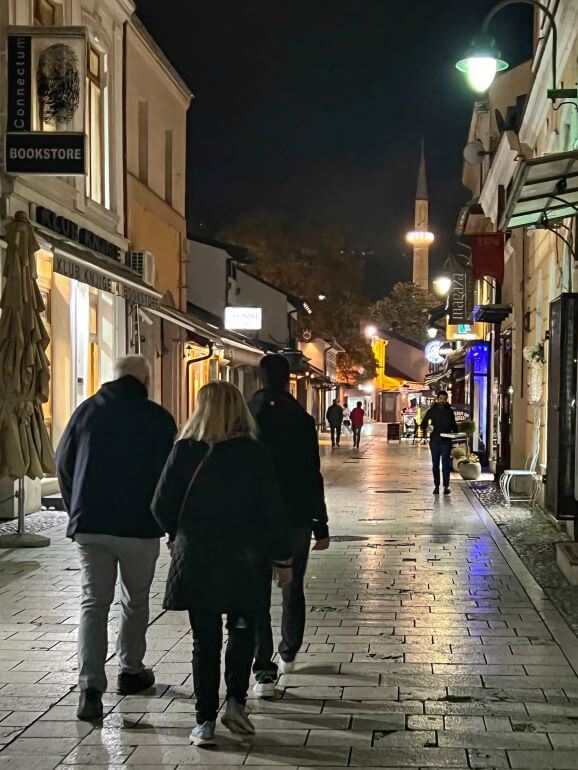
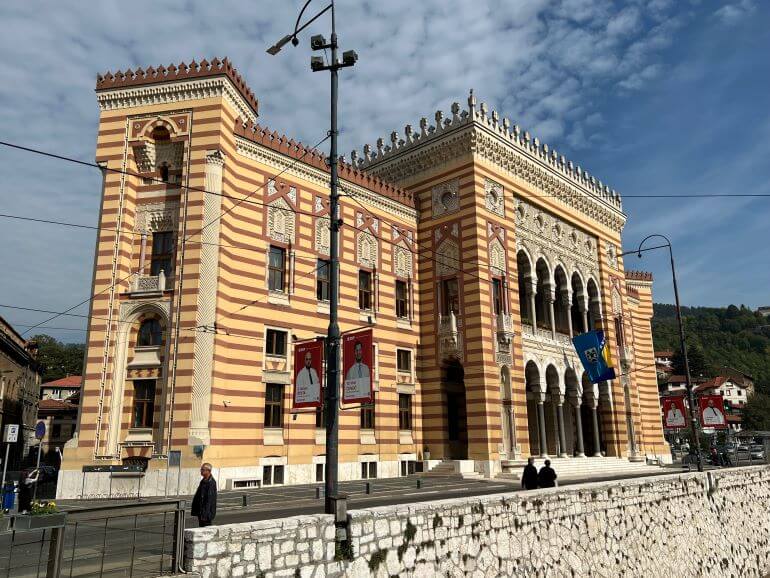
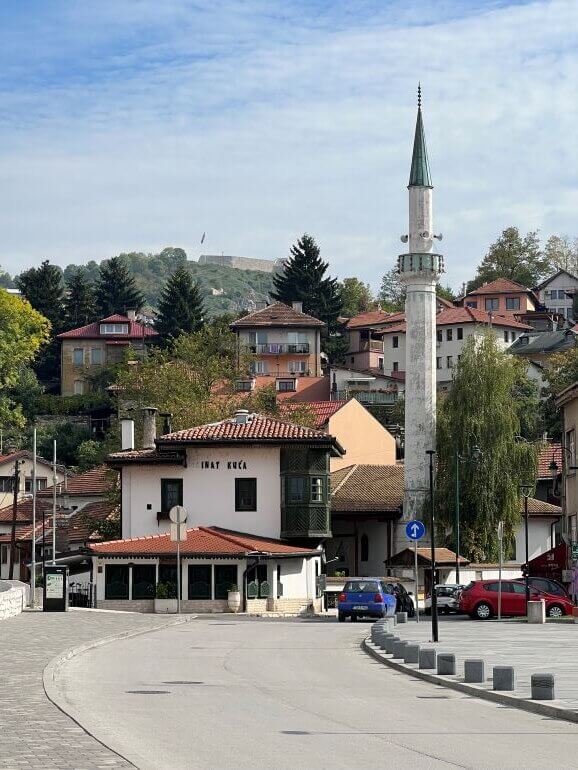
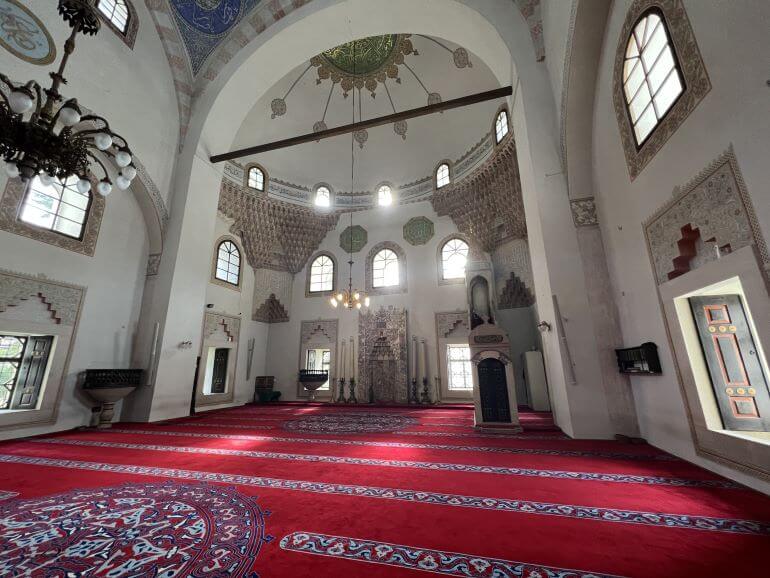
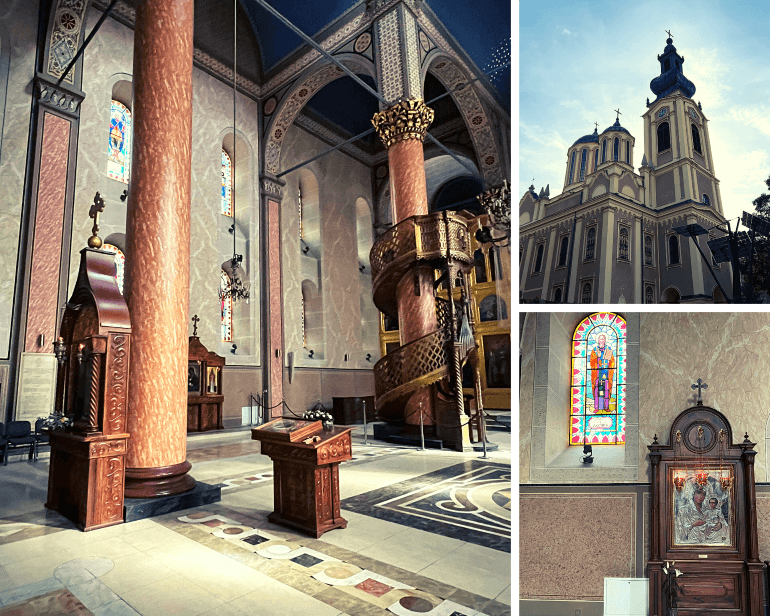
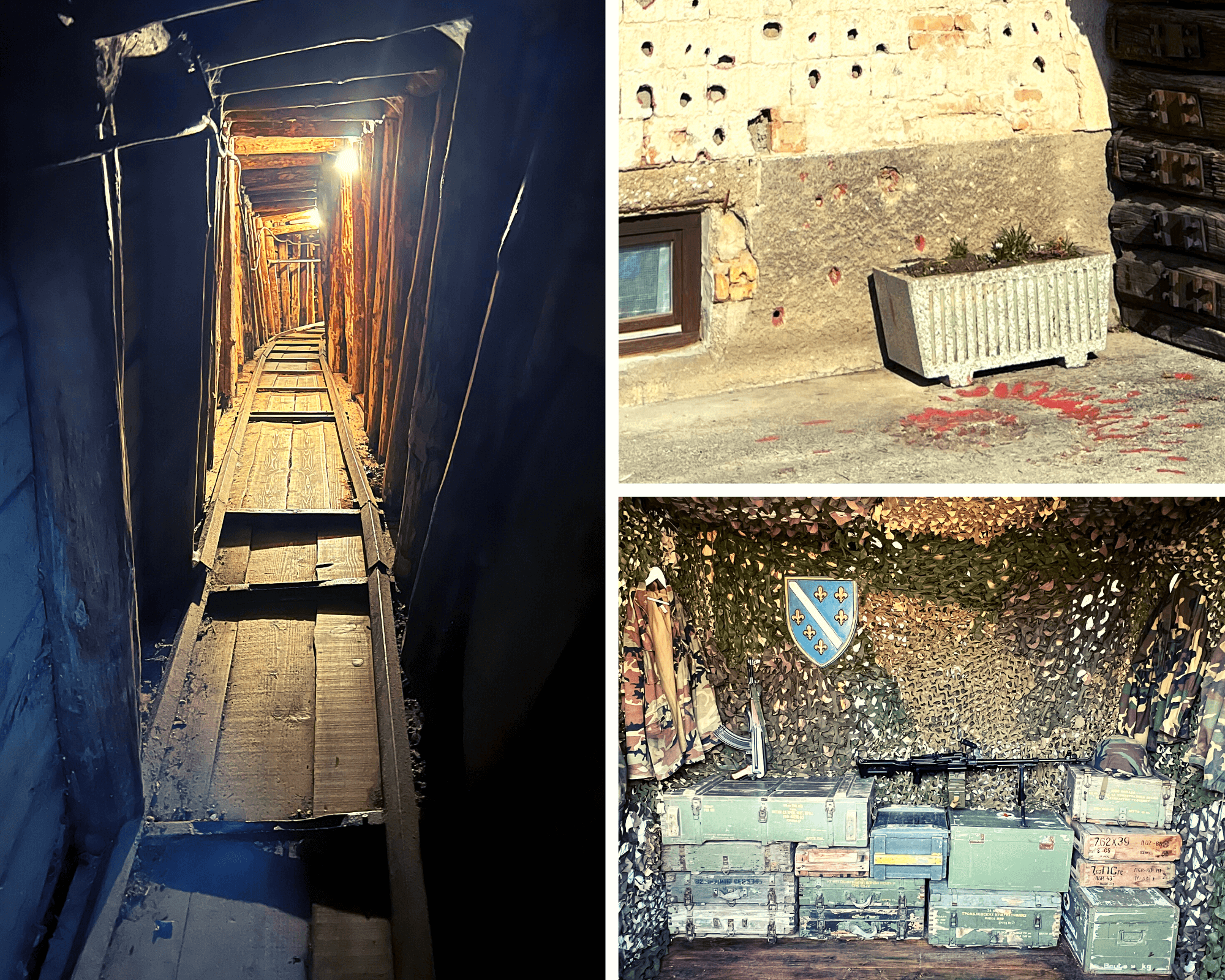
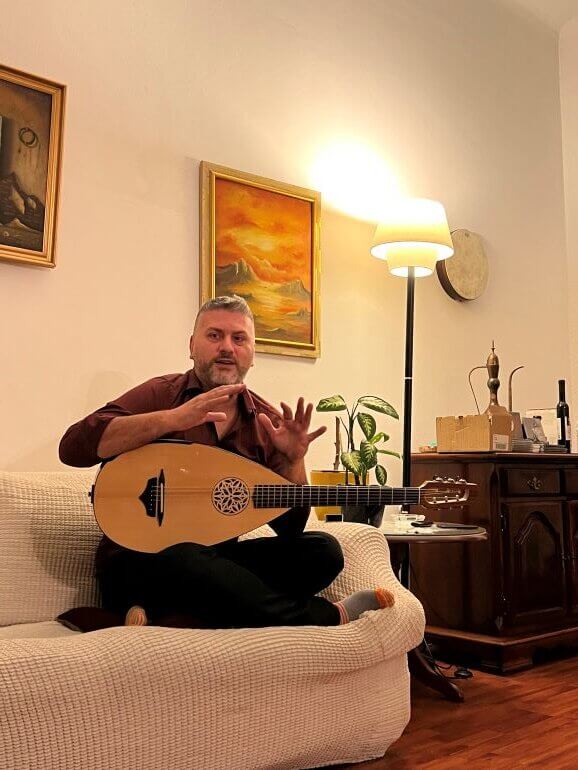
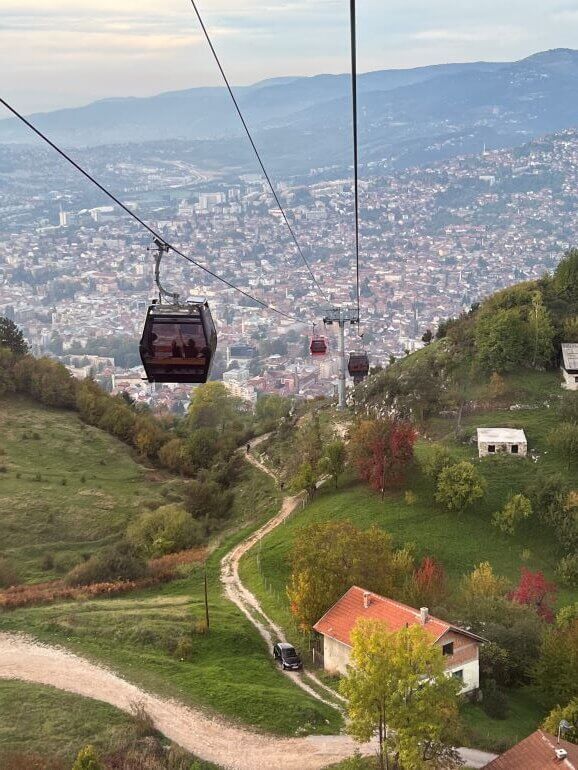


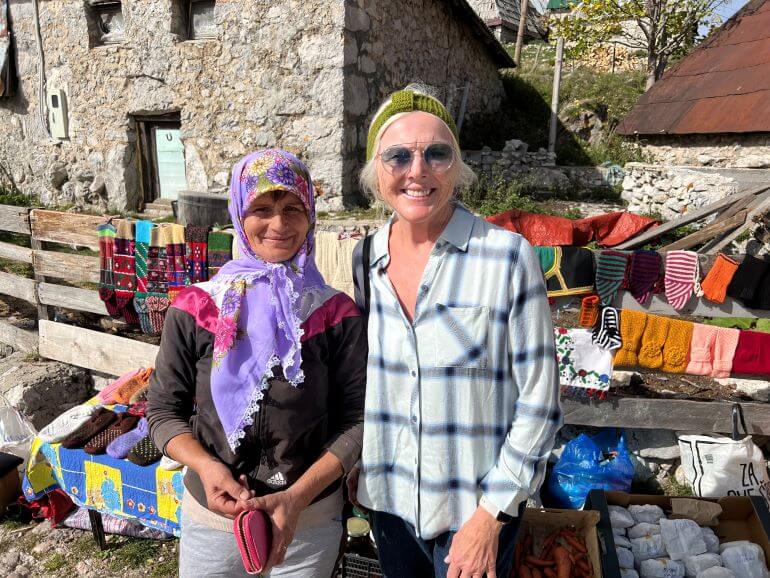
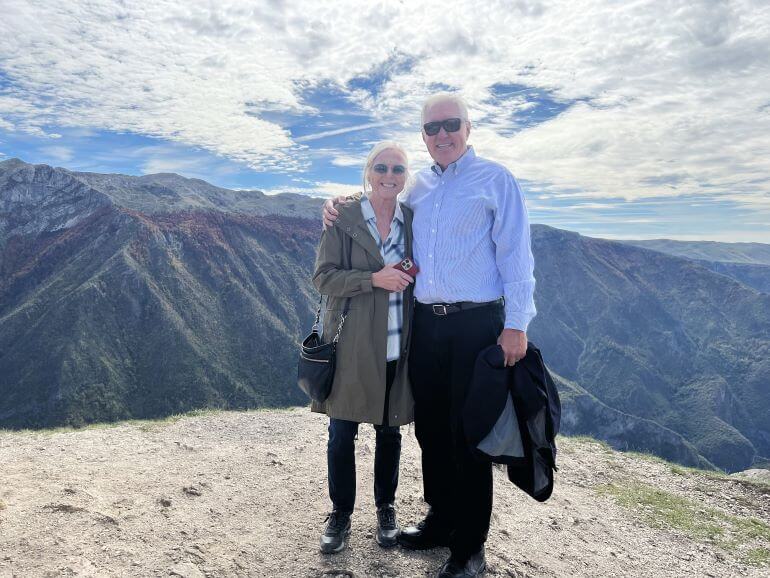
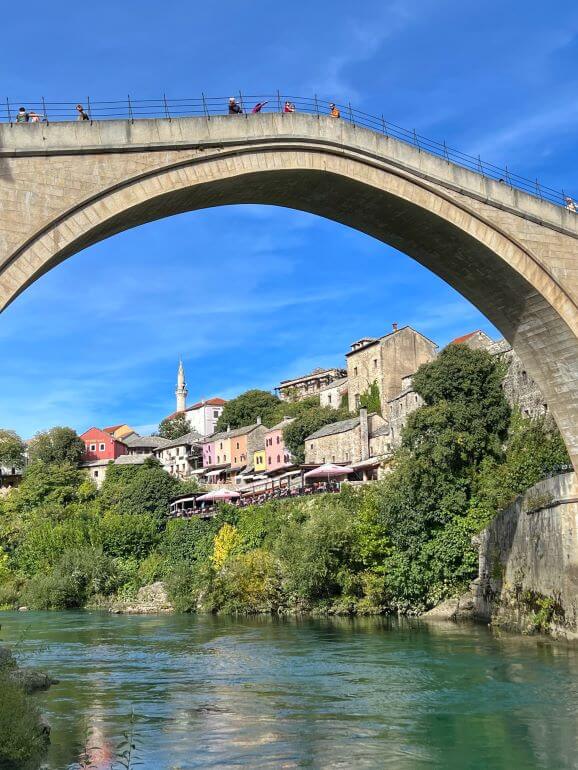
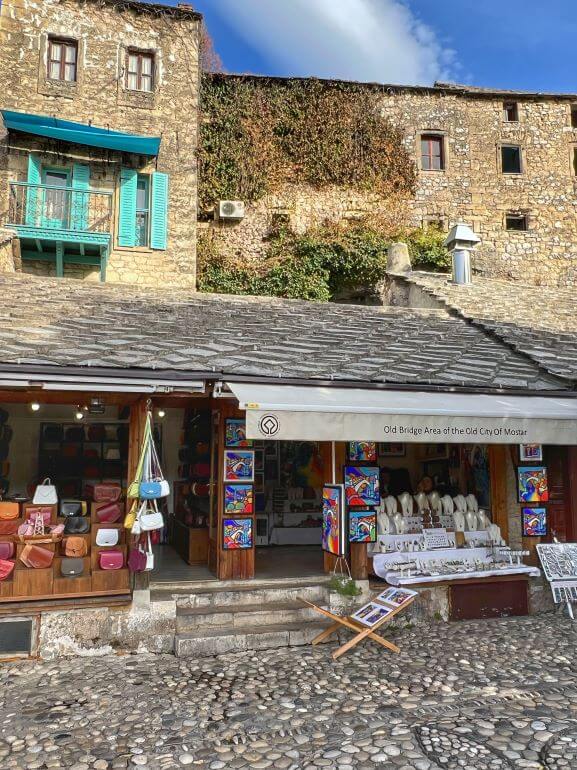
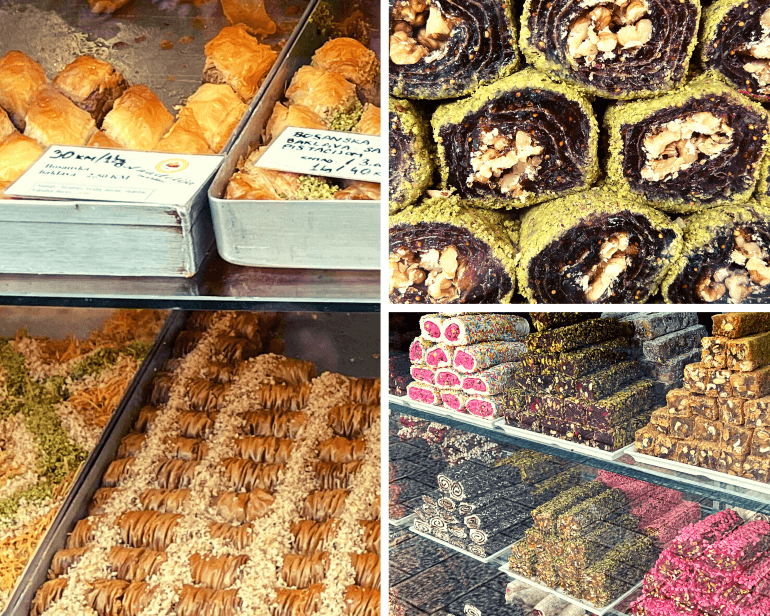
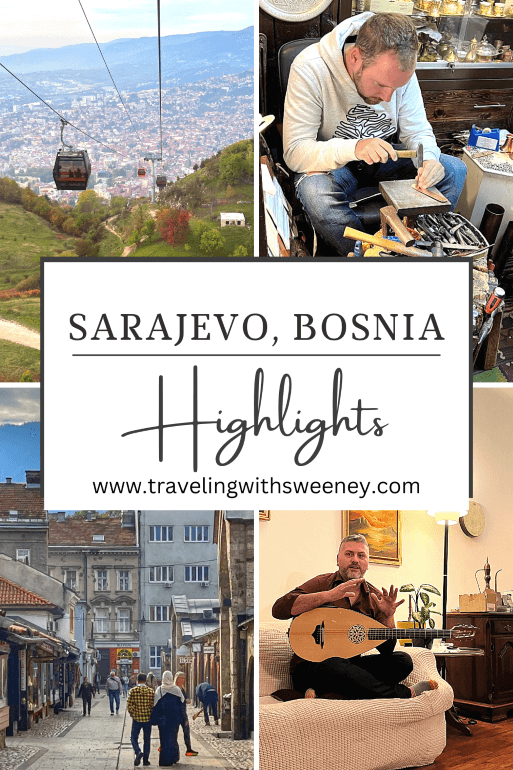
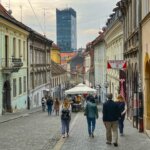
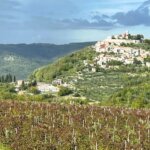
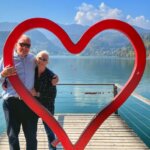
I’ve never visited this part of the world but it sounds like the Collette Taste of the Balkans tour was an excellent way to explore a less-traveled area. Thanks for exposing me to what these countries have to offer.
I remember feeling horrified following the Bosnia Civil War and seeing Sarajevo and her population brutalized, especially after hosting the Olympics. Now it feels like a prequel to the current war in Ukraine. I was happy to follow along on your Collette Balkans tour via Facebook.
What a fascinating trip! It sounds as though the Collette Tour really got you deep into the culture and landscape of Sarajevo Bosnia. The Sarajevo flowers must have been an especially poignant sight to see.
A lovely and comprehensive post with beautiful photographs. From such a troubled part of the world, to a traveller’s destination of note, it all looks so interesting. I’ve been to Croatia, but Sarajevo is now definitely on my must-sees to understand more about the history and culture.
Its interesting to learn where the country’s name came from.
I’ve not known much about Bosnia besides the war and thanks for this amazing insight.